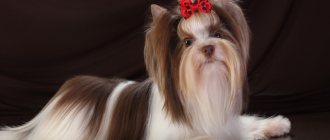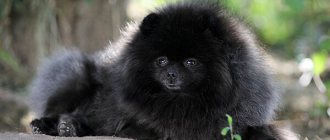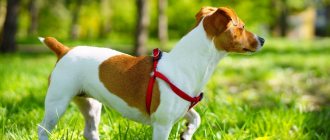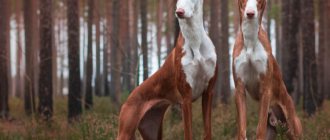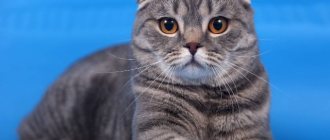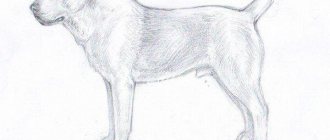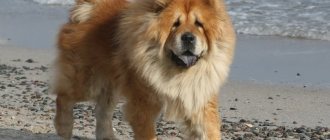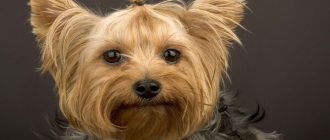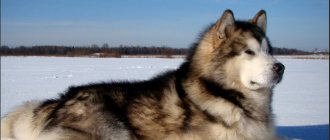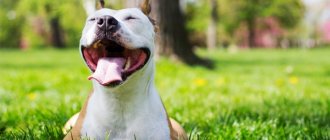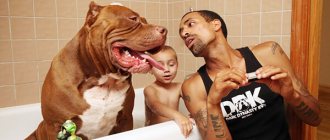Yorkshire terriers come in different colors, but white coat color is especially popular among owners of dogs of this breed, although its owners are not recognized as purebred Yorkies.
The breed appeared in the 19th century in the counties of Yorkshire and Lancashire in Great Britain. This is where the name came from.
The dog is miniature in size. Yorkies have a cheerful, inquisitive character, and they are very smart.
The advantage of keeping this breed is not only its small size, but also the absence of undercoat, so the pet does not shed or cause allergic reactions.
In this article we will talk about white Yorkies and also show their photos.
Do white Yorkies exist?
There is no pure white color in the breed.
There are three colors close to white:
- beaver;
- biro;
- golddust.
NOTE!
But still, Biewer Yorkies have more white color. They often come in three colors, with white being the predominant color. But everything will depend on the individual characteristics of the dog.
Biro-Yorks have no black coat at all. They are characterized by a chocolate-white combination with a golden tint.
White color also predominates in Yorkie mermaids, which are also called the “Russian mermaid”. Many call it an independent breed. Speaking about light color, it is called white or off white.
If we talk about the standard Yorkshire Terrier, then its color is white with dark spots.
Upbringing
Yorkshires are smarter than many other dog breeds, so training is usually not particularly difficult. If you start from an early age, the task will turn out to be extremely simple. The first thing you should prepare your dog for is the existence of various loud sounds. At first, you shouldn’t even talk too loudly or turn on the music “to the fullest” - let the dog gradually get used to the existence of noisy people, technology and the metropolis.
The same goes for being in too close contact with people. Although you want to immediately cuddle the baby and throw out all your tenderness on him, you shouldn’t do this. Let your pet learn about the world around him gradually, and only when he is completely comfortable at home and gets used to everyone in the household, start showing him the world around him. The correct training procedure allows you to raise a confident dog that is not afraid of any challenges.
You can train an animal to use the toilet at home in the same way as representatives of other breeds. The dog usually feels the urge soon after eating, the readiness to go to the toilet is expressed in a certain fussiness and slight nervousness, so keep an eye on your pet, and as soon as he begins to show such activity, immediately grab him and take him to where you have equipped the tray
It is important to start setting it up before the puppy arrives - then training will happen more quickly
Don’t forget that you need to praise your four-legged dog for doing things correctly by treating him to something tasty. To avoid unpleasant surprises in the early stages of training, you can dress the animal in a diaper, which, however, will have to be changed after each time, even if the baby correctly understood where his toilet is.
Despite the fact that the dog is smart and understands commands well, the problem with training it is that the pet is restless - it is too active and cannot concentrate on training or any other task for too long. To quickly convey to your mentee that you are pleased with him, decide in advance on a word or phrase that is a universal expression of approval. The dog will quickly remember it and will understand that its actions are positive.
Yorkshiremen are able to entertain themselves on their own - they easily come up with games for themselves, which is generally good. Another thing is that in their fun they often tend to use objects and things that are not at all intended for this.
The owner’s task is to stop such attempts in time. It is unacceptable to use physical punishment - only a stern tone and the cry of “fu” are suitable, and even then only immediately at the “moment of the crime”, and not sometime later. For a Yorkshire Terrier, it will be very useful to accustom him to a certain schedule according to which he will eat, walk, bathe, and so on.
History of appearance
This new type of terrier was initially rejected, but the attractive appearance of the puppies prompted breeders to identify them as a subspecies of Yorkshire terriers and call them Biewer-Yorks - on behalf of the German dog breeder Werner Biewer , who took up the issue of breeding a new subspecies of the breed.
This happened in 1984, and in 1989 the new breed received an official calling among dog handlers. The first puppies, which became known as Biewers, had white fur with black golden stripes.
In 2007, Biewer Yorkies were brought to Russia.
Expert opinion
Kozhevin Semyon Kirillovich
Expert dog handler.
In its external descriptions, the Biewer resembles the Yorkshire Terrier in every way. The dog is distinguished by its compact size, proportional build, straight and silky coat. All terriers, including white ones, have a friendly character. They get along well with children and become family favorites.
Unrecognized colors
It is worth noting that not all dogs fit the described breed standard. There are a considerable number of terriers that have rather unusual colors. Unrecognized colors that do not fit the standard include the following six types of coat colors.
Biro York
These dogs are very similar in appearance to Biewer Yorkies. Their main feature is that they do not have the gene that is responsible for the appearance of black fur. That is why such Yorkies are only light in color.
Additional Information! This variety of Yorkies appeared relatively recently and therefore they do not have a standard.
Beaver York
The Biewer Yorkie is a rare breed of Yorkie. They are quite rare. Biewers look unusual; their appearance is in many ways similar to Biro-Yorks. They are also painted in light colors. However, some dogs have darker fur. Most often it occurs on the head. The body is painted white, sometimes with a silver tint.
Golddust
Such dogs are considered the rarest, since they are not found as often as others. The main distinguishing feature of these dogs is their unusual golden coat color.
Until 2007, they could not be classified into any breed. However, in the middle of this year they were officially identified as a separate breed called “Golddust”. The homeland of these dogs is Germany, but today they can be found in other countries.
Mermaid
These are quite beautiful and unusual dogs that can be called mermaids. This variety was bred relatively recently in Russia. These dogs differ from other animals in their long and thick hair. It is painted golden, with a slight yellowish tint.
Chocolate
The Chocolate Yorkie is one of the most beautiful representatives of the breed. Sometimes dog breeders decide to get themselves chocolate terriers. They, like the silver Yorkie, have a fairly thick coat. At an early age, such dogs have softer hair. However, over time they become rougher. The coat is dyed dark. On the head it is completely black, on the body it is slightly lighter.
Important! The coat of chocolate York terriers is uniform, without multi-colored spots.
Black
Dogs with jet-black fur are considered quite rare. Therefore, most black terriers have a grayish or brownish coating on the surface of the body. Even if the dog was perfectly black at an early age, over time its shade may change slightly and become lighter.
Advantages and disadvantages
Advantages of dogs of this breed:
- have high intelligence and are quickly trainable;
- they love attention and are happy to demonstrate their skills, not without encouragement, of course;
- They love to spend time playing games, so they are ideal for children aged 6-7 years. But you should not leave small children with the dog;
- the dog is great for energetic people - it will accompany its owner on walks, jogs, etc.;
- Yorkshire Terrier is brave. He can rush into battle even against a large dog. But in order to protect the baby from injury, such collisions should not be allowed;
- Yorkies have good hearing and vigilance, they bark loudly, and they have guarding qualities;
- Thanks to its compact size, you can take your pet on a trip;
- Due to the lack of undercoat, the Yorkshire Terrier does not cause allergies.
Disadvantages of the breed:
- sometimes the Yorkshire Terrier can be disobedient and reluctant to follow the owner’s commands;
- The pet can sometimes be capricious and wayward. But this is subject to the lack of proper education on the part of the owner;
- do not get along well with other animals in the house, are not always friendly with guests, and may even bark at them;
- while walking, scandals often break out with passing dogs, even if the latter are much larger in size;
- If there is a small child under 6 years old in the house, then there is no need to purchase Yorkies yet. Children often injure fragile animals, and a dog may even bite if the baby causes her discomfort;
- Yorkshire terriers require a lot of attention to their person, they will be intrusive, following on the heels of their owner;
- The breed is picky about food; not all foods are suitable for Yorkies. If you switch to dry food, it is better to take super premium food;
- In winter weather, your dog will need clothing and accessories.
Read about other advantages and disadvantages of Yorkshire terriers here.
What is the breed for?
Nowadays, Yorkies are wildly popular. Carrying a small dog with you has become fashionable among celebrities. Simple families adopt Yorkies for their good nature and cheerful character. Although Yorkies originated from hunting breeds, now they are bought only as pets.
The Yorkshire Terrier is ideal for both experienced owners and beginners. These "living toys" are intended for aesthetic taste.
Terriers are companions that follow their owner on a hike, on vacation or for a morning run. They will keep you company on a trip on any type of transport. Dogs adapt well to life in the city, although they have an independent character.
Distinctive features
Yorkshire White Terriers are among the smallest dogs. Their maximum weight reaches 3.1 kg.
But height and lowest weight are not limited to certain limits. Breeders recommend purchasing an adult dog weighing from 2 to 3 kg.
All indicators of both height and weight are purely individual. Yorkies grow up to a maximum of 28 cm, the average height of a pet is 17 cm. At the same time, females are slightly taller than males (about 5 cm) and 30 grams heavier.
external indicators also serve as features of Yorkies :
- the coat is long, falling evenly from the sides;
- The parting starts from the tips of the nose to the tail;
- ears stand up, eyes and nose are black.
Appearance of the Yorkshire Terrier
This miniature dog is quite strong and dignified. Its height from floor to withers is from 15.24 to 23 cm. Standard weight is from 1.81 to 3.17 kg (no more than 3 kg for exhibition specimens).
Puppies have black and brown coats that can be combined in different ways. As they grow older (usually at the age of 5-6 months), the black color gradually begins to acquire bluish tints, and the brown color becomes lighter. By the age of one and a half years, the Yorkshire Terrier's coat from the scruff to the base of the tail already has a dark bluish-steel color, and the muzzle, chest and paws are colored a rich golden fawn.
Frame
The Yorkshire Terrier is harmoniously built, its body has a proportional structure. He is quite muscular and elegant at the same time. The dog's back is quite short and horizontal. The height at the withers corresponds to the height of the croup
Yorkie's posture is proud, sometimes this little one looks touchingly important
Ears
Yorkie muzzle
The ears are miniature, V-shaped, erect, located not too far from each other, covered with soft short fur. The color of the coat is light golden.
Teeth
The Yorkshire Terrier is characterized by a scissor bite: the upper canines slightly cover the lower ones, and the incisors of the lower jaw are closely adjacent to the back side of the upper, forming a kind of lock.
Limbs
The Yorkie's front legs should be slender and straight, with no elbow bones protruding in or out. The hind legs, when viewed from the rear, should look straight; when viewed from the side, a slight bend is noticeable. The claws on the paws are black.
It is customary to remove dewclaws (dewclaus) on the hind legs, and at the request of the owners on the front legs.
Tail
The tail is traditionally docked to medium length. Cupping itself is not necessary. The tail is densely covered with hair, the color of which is darker and richer than that covering the body.
Wool
The pride of the Yorkshire Terrier is its thin, shiny, silky, completely straight coat, which is often called hair. In the classic version, it should be divided from the base of the skull to the tip of the tail and fall completely evenly and straight on both sides of the body, reaching the floor. In order for such a handsome man or beauty to always look impeccable, you will need to devote a considerable amount of time to them every day. This makes sense if the Yorkie is a participant in exhibitions, the hero of TV shows, or is invited to photo shoots. However, among the owners of such “super stars” there are many people who are simply selflessly devoted to this breed of dog.
Yorkshire Terrier after grooming
Most owners of Yorkshire Terriers prefer to cut their hair. There are several dozen haircut models: from simple to incredibly sophisticated. The procedures take place in grooming salons or at home with the invitation of a specialist. Sometimes short-haired Yorkshire terriers create a sensation no less than their long-haired relatives who look like aristocrats.
From time to time, a genetic leap occurs in the Yorkshire Terrier's nature. This is called the "return gene" or simply "return". In this rare case, your black-brown pet's coat will not turn bluish-gold as expected. The black color will remain that way, without any hint of blue, and the brown will turn into golden-red. This Yorkie is called Red Legged Yorkies, literally - red-legged Yorkshire terrier.
Lifespan
Because of their agility and playfulness, Yorkshire Terrier dogs enjoy good health. Their muscular and cardiovascular systems are strengthened through constant movement.
IMPORTANT!
And if there is proper care, the life expectancy of doggies can increase.
On average, white Yorkies live 13-16 years, with a maximum life expectancy of 20 years.
Mini Yorkie
The main feature of mini Yorkies is their miniature size. They weigh about 2 kg.
This causes some difficulties in keeping and caring for such pets:
- they must be constantly monitored and should not be left on beds, sofas and other surfaces elevated above the floor - the dog may fall and damage the bones;
- You should not get a Mini Yorkie if there is a child at home, as children often do not calculate their strength when playing with a pet and can damage the musculoskeletal system;
- There are some difficulties in breeding the breed, so if you are not a professional, then you should not do it.
Important! If you decide to purchase a mini Yorkie, then buy a puppy only from trusted pets. Some dog breeders, in order to breed this subspecies, feed the puppies poorly or do not properly monitor their health.. Interestingly, these are not the smallest representatives of the breed! There are also so-called “micro-Yorks” or “super-mini”, which weigh about one and a half kilograms or even less
Interestingly, these are not the smallest representatives of the breed! There are also so-called “micro-Yorks” or “super-mini”, which weigh about one and a half kilograms or even less.
Such small dogs have health problems, most often with the musculoskeletal system. In addition, they live shorter than standard Yorkies.
Baby - face Yorkshire terrier
The peculiarity of this subspecies is that the muzzle does not meet the standards of the Yorkshire Terrier breed.
Here's what it is:
- the head is round in shape;
- the muzzle is shorter than that of a traditional Yorkie;
- ears are below forehead level;
- the eyes are large, protruding, which makes the look seem surprised, a little like a doll’s eyes;
- upturned nose.
Thanks to this, the muzzle looks very cute, hence the name: baby face, because the muzzle resembles the expression of a child, a doll. However, these features cause specific health problems, for example:
- chronic conjunctivitis;
- frequent eye injuries (due to bulge);
- teeth often fall out (so you have to carefully monitor them);
- snoring and grunting (due to improper placement of the nasopharynx).
You can buy this cute pet only with unlimited attention and care.
White color options
The White Yorkie cannot be classified as a breed standard .
White fur usually has a yellowish tint. But with age there is a gradual fading to white.
The remaining areas contain tan, which may be consistent with the breed.
This color is popular.
Sometimes the Golden York variety is called the white Yorkshire terrier, since its coat can be light in color with a golden coating.
Does the puppy's white color change as it ages?
Color change in Yorkshire Terrier puppies occurs from 4 months.
If a dog was born with a silver-blue color, then by 6 months some representatives of the breed lighten significantly, acquiring a whitish color. By the age of one year, they acquire a steel-white color with a silver tint, which is extremely undesirable for breeders, as this indicates that the Yorkie is not purebred.
World's Leading Yorkshire Terrier Kennels
For anyone who is going to buy a Yorkshire Terrier puppy, it is important that the dog is truly purebred, healthy, and free of hereditary defects and diseases. For many, the puppy’s prospects as a future champion are also important.
That is why information about those kennels whose owners have won world fame as the best Yorkshire terrier breeders is of great importance.
The Italian kennel of Antonella Tomaselli “Delle Antiche Mura” is registered with ENCI and FCI. The owner of the kennel is the author of many articles and several books on the breed, as well as the vice-president of the Italian Yorkshire Terrier Club, officially recognized by ENCI in 1995. Among the famous pets of “Delle Antiche Mura” the following world champions and main prize-winners of many Italian and international exhibitions should be mentioned: World Champion Agapi Delle Antiche Mura, Ch. FALPALA' delle Antiche Mura and Ch. FILI delle Antiche Mura, Ch. EDIZIONE SPECIALE delle Antiche Mura, Ch. EDIZIONE LIMITATA delle Antiche Mura
The French kennel "De Penghibur", founded in 1965, belongs to Mme Marguerite Gerard - the undoubted leader and inspirer of Yorkshire terrier fans in his country. Among the numerous champions, the most famous were Trudy de Penghibur, Ch. Int. Tilbury de Penghibur, World Champion Uddersfield Ben de Penghibur, World Champion Hooligan de Penghibur, World Champion Jofi de Penghibur.
The Swedish kennel of Yorkies “Debonaire's” is famous for its champions Passion For Class, Debonaireґs Believe In Music “Strauss”, Pearlstring Come Sway With Me “Sway”, Queen Of Hearts. The owner of the kennel, Bernice Unden, is a member of the Swedish Yorkie Society, the Swedish Kennel Club, and the national Terrier Club.
The Norwegian nursery "Henceforths" is famous for its champions N Ch Henceforth's Casino Royale, Sharmnatan's Everlasting Love, Hunderwood Frenchy Boy, Miss Behavin, Vodka Shot. The owner of the nursery, Henny Lidal, also does a lot of work with the Internet audience - the nursery’s website has a lot of useful information about the breed. As well as the results of exhibitions from around the world.
The owner of the Spanish kennel "De La Villa y Corte" Ana Mesto is the editor-in-chief of one of the best dog magazines in the world - "La Revista del PERRO". Famous dogs of the kennel: Ford-Azul, HURI, Xantia.
The most famous nursery in Mexico is “Guemart”, which is rightfully proud of its champions Kendos Kissimme, Magic Millionaire, Just a Kiss. Kennel owner Jesus Guerrero began training Yorkies in 1996.
The owner of the French kennel “LA Pam'Pommeraie” Simone Cheveu has been breeding Yorkshire terriers for 18 years. Champions such as Fanfan La Tulipe, Grace-Kelly, Get-Up, Merry Poppins brought fame to the nursery.
Another nursery in France, Du Domaine De Monderlay, belongs to Marc Mansuet. Mark is the winner of the "Big Breeding Prize". The most famous dog of the kennel is International Champion, World Champion, American Champion Jubilant du Domaine. In 1997, the dog was recognized as the Top Terrier and the Top Dog of France. Other famous breeds from the nursery include Jin-Jin, Louis, Nextime, Lollipop, Lea and Malango.
The history of Nicoletta Pollini's Qoccle's nursery began in 1983. The most famous people from Qoccle's are Oliver Lightsome, Kayak, Dimmi DiSi, Oliverina.
By choosing a puppy from a trusted kennel, the owner insures himself in advance against a lot of unpleasant surprises. Fortunately, today you can find a wonderful Yorkshire Terrier without entering into tedious correspondence with foreign breeders.
How to choose a puppy?
When purchasing a white Yorkie, there are many factors to consider. The fact that a puppy is playful and cheerful does not mean its health.
You should pay attention to everything - the dog’s fatness, the quality of its coat, how active and mobile the baby is. The ears and oral cavity are examined.
Regarding the coat, it should be shiny, healthy in appearance, and shimmer in the light.
Pay attention to the nose, it should be wet and not hot, even if the Yorkie spent time playing.
The corners of the eyes should be clean and free of discharge.
There is excitement and life in the look.
Puppies of this breed, even white ones, have dark eye color.
Inspect the ears - their insides should be clean, the presence of dirt and especially crusts is unacceptable. The skin inside the ears is pale pink.
Feel free to sniff the area of the ears and mouth; there should be no unpleasant odor coming from there. If it is present, then this may indicate worms, infections or ear mites.
When examining your dog's mouth, if you notice bluish discoloration, pale or whitish gums, you should ask the breeder about the puppy's health. Such symptoms may indicate anemia or a lack of other nutrients in the animal's body.
NOTE!
You also need to examine the puppy’s teeth - there should be as many of them as are appropriate for the Yorkie’s given age. The teeth should be straight, especially if you are choosing a dog for exhibitions and breeding. If there are deviations in the contact of the incisors, then the pet will be considered a non-exhibition specimen.
But since the Biewer-York (it is their white coat color that most often predominates) is considered not a show breed anyway, no special attention is paid to the dog’s bite.
Content
The most difficult in the life of a puppy and its owner are the first 2 months after the baby arrives in a new home. You will have to carefully monitor so that this miniature creature does not swallow something that is out of place, so that no one steps on it and pinches it. During this period, you should not host noisy companies at home - this will prevent the dog from successfully adapting. In addition, if there are small children at home, you should limit their interaction with the puppy, which can only take place under the supervision of adults. Beavers are very clean and not at all burdensome.
At home, the dog must have its own sleeping place, toys and bowls. If desired, the baby can be taught to urinate in a diaper; this will help owners in the future avoid unwanted walks in rainy or cold weather. Of course, this does not mean that the dog can sit in the apartment for days on end. The Biewer Yorkie, like any other dog, needs regular physical activity, which will help the puppy to develop correctly physically and psychologically. Socialization plays a very important role, getting to know new smells, people and animals.
One of the undoubted advantages of the breed is the absence of shedding and specific odor.
Grooming Biewer Yorkie
This is not to say that caring for a Biewer is very difficult, but you will have to devote time to the dog’s appearance every day. An animal should be taught hygiene procedures from an early age, even if initially they are more of a symbolic nature. The puppy must get used to hands, tools and actions.
The eyes should always be clean and healthy. To do this, they are washed daily. In addition, be sure to carefully remove hair from the area around the eyes and prevent the formation of tangles. It is recommended to clean your ears once a week. The fur inside the ear canal is plucked because it interferes with the natural cleaning of the ear canal. If you do this regularly, the dog will not experience severe pain.
To make paw care easier, the hair between the toes and around the pads is trimmed. After walking, the crumbs are lubricated with rich cream or oil to prevent cracks from appearing. Once every 7-10 days, the paws are examined and, if necessary, the claws are trimmed.
Brush your teeth at least once a week. Considering that Biewers have a predisposition to diseases of the oral cavity, it would not be superfluous to massage the gums with propolis while brushing their teeth.
Grooming
The dog's fur deserves special attention. It is soft, long and prone to matting. Therefore, you need to brush your dog daily, preferably twice a day. It is recommended to bathe your Biewer no more than once a week. During water procedures, use shampoo for the appropriate type of coat. After bathing, be sure to apply balm and conditioner to make combing easier.
Many owners prefer to cut their Bievers, which makes caring for them much easier. You can choose any haircut to suit your taste.
Feeding
Most breeders prefer to feed their dogs prepared food. Babies eat very little; even holistic food is relatively inexpensive. In addition, this option is convenient: it eliminates the need for cooking and administering vitamin and mineral supplements. Portions are calculated by weight based on the recommendations on the packaging.
Some Biewers do not eat in moderation, which can lead to obesity. The dog must be weighed periodically and if it gains extra grams, the amount of food should be reduced.
If desired, you can stick to natural products. In this case, porridge is prepared with the addition of meat (beef or poultry) and vegetables. The diet may also include dairy products, a little honey, and boiled sea fish. For every 500 g of weight there is approximately one tablespoon of food without top. To prevent plaque, and especially during teeth changes, beavers can be given compressed beef tendons.
The Biewer bowl should be at chest level with the dog. To do this, it is placed on a small shelf-stand.
